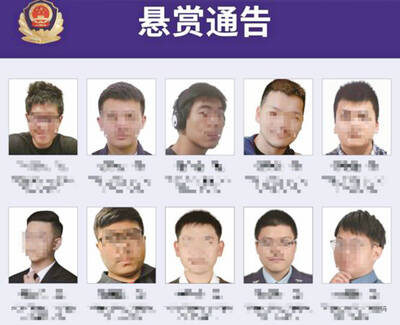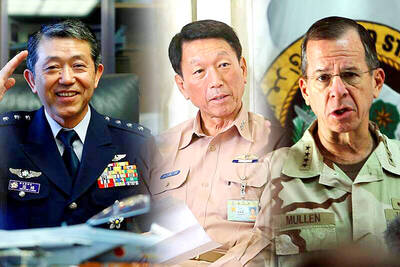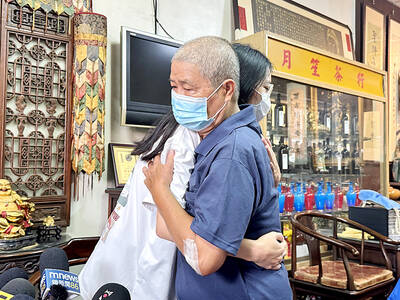With the anniversary of the 921 earthquake upon us, Environmental Protection Administration (EPA) officials have conceded that only a limited amount of quake waste has been recycled.
Statistically, less than 4 percent of construction waste created during the earthquake last year was recycled. Much of it has simply been buried in landfills and covered over.
The result is far from the goal set by the EPA at a press conference last December.
EPA officials said at the time that they were confident they could recycle 20 to 30 percent of such waste to ease the pressure on the environment created by mining for gravel.
"The limited budget allowed us to list only one-twelfth of the existing 12 million m3 of construction waste to be recycled," Chen Hung-yi (
Among the estimated one million cubic meters of construction waste designated as recyclable, Chen said, administration officials had so far only found use for 450,000m3 of it.
The EPA came up with the recycling project last year based on a study by the Taiwan Construction Research Institute (TCRI,
Immediately after the earthquake, the environmental agency established 106 temporary dumps for waste, which did not undergo environmental impact assessments, which would ordinarily have been required by law.
This was authorized by an executive emergency decree announced by then President Lee Teng-hui (
Since these sites covered a total area of 280 hectares and were spread all over the country -- from riversides to remote mountain areas -- environmental officials generally tried to close the sites as soon as possible to avoid pollution problems.
In addition, officials said that part of the construction waste would be recycled as materials for construction projects in central Taiwan.
Disappointingly, EPA officials received only NT$700 million from the central government and so only have been able to deal with 69 out of 106 existing disposal sites.
So far, of these 69 sites, only about half have attracted interest from private firms or government agencies.
The government is offering to pay NT$300 for each cubic meter of waste removed, which the companies say is far too little to cover the costs of removal.
There are also problems surrounding quality. The use of quake waste as a base for roads is unprecedented in Taiwan and construction firms have been reluctant to use it.
Last December -- to earn the confidence of builders -- the EPA's central Taiwan division invited construction firms to exhibitions of processed quake waste, to show how they could be used as raw materials for new buildings.
Until June, however, no company had agreed to accept quake waste. They suspected that the quality of the pre-treated rubble might not be as good as gravel taken directly from mountain areas, as is usually done.
In June, Minister Without Portfolio Tsay Ching-yen (
The engineering bureau accepted 50,000m3 of rubble for use in the Wur Ramp (
Taichung Harbor also agreed to take 400,000m3 of rubble for land reclamation.
"I feel so sorry to see the recycling project we presented last year turn out like this. We believe that up to 70 percent of quake waste could have been recycled for use as construction materials," Chern Jenn-chuan (陳振川), president of TCRI, told the Taipei Times.
Chen said that not using recycled quake waste efficiently was regrettable, since Taiwan suffered a chronic shortage of gravel.
Chen stressed that the quality of quake waste was not a problem.
According to TCRI engineering researchers, ground construction materials, while not as fine as the gravel used for building houses, are the best choice for road bases because they are more resistant to liquefaction when earthquakes strike.
According to the TCRI, after a deadly earthquake hit California in 1994, 51 percent of quake waste was recycled.
"Due to a lack of money, we had no choice but to bury quake waste at some sites directly without taking out recyclable material," said the environmental administration's Chen, adding that a thin layer of vegetation was planted on top to restore the area to its natural state.
Under pressure from environmental activists, the EPA has spent NT$86 million monitoring the environmental impact of the temporary disposal sites.
"At a site in Tungshih Township (
Environmental officials, however, admitted that a long-term comprehensive monitoring project would have to be carried out. They have requested a total of NT$680 million over the next three years for reconstruction work, including monitoring closed disposal sites and recycling quake waste.
Currently, a general monitoring project has been carried out at 25 disposal sites with civil engineers.

A Chinese aircraft carrier group entered Japan’s economic waters over the weekend, before exiting to conduct drills involving fighter jets, the Japanese Ministry of Defense said yesterday. The Liaoning aircraft carrier, two missile destroyers and one fast combat supply ship sailed about 300km southwest of Japan’s easternmost island of Minamitori on Saturday, a ministry statement said. It was the first time a Chinese aircraft carrier had entered that part of Japan’s exclusive economic zone (EEZ), a ministry spokesman said. “We think the Chinese military is trying to improve its operational capability and ability to conduct operations in distant areas,” the spokesman said. China’s growing

Taiwan yesterday denied Chinese allegations that its military was behind a cyberattack on a technology company in Guangzhou, after city authorities issued warrants for 20 suspects. The Guangzhou Municipal Public Security Bureau earlier yesterday issued warrants for 20 people it identified as members of the Information, Communications and Electronic Force Command (ICEFCOM). The bureau alleged they were behind a May 20 cyberattack targeting the backend system of a self-service facility at the company. “ICEFCOM, under Taiwan’s ruling Democratic Progressive Party, directed the illegal attack,” the warrant says. The bureau placed a bounty of 10,000 yuan (US$1,392) on each of the 20 people named in

Nine retired generals from Taiwan, Japan and the US have been invited to participate in a tabletop exercise hosted by the Taipei School of Economics and Political Science Foundation tomorrow and Wednesday that simulates a potential Chinese invasion of Taiwan in 2030, the foundation said yesterday. The five retired Taiwanese generals would include retired admiral Lee Hsi-min (李喜明), joined by retired US Navy admiral Michael Mullen and former chief of staff of the Japan Self-Defense Forces general Shigeru Iwasaki, it said. The simulation aims to offer strategic insights into regional security and peace in the Taiwan Strait, it added. Foundation chair Huang Huang-hsiung

PUBLIC WARNING: The two students had been tricked into going to Hong Kong for a ‘high-paying’ job, which sent them to a scam center in Cambodia Police warned the public not to trust job advertisements touting high pay abroad following the return of two college students over the weekend who had been trafficked and forced to work at a cyberscam center in Cambodia. The two victims, surnamed Lee (李), 18, and Lin (林), 19, were interviewed by police after landing in Taiwan on Saturday. Taichung’s Chingshui Police Precinct said in a statement yesterday that the two students are good friends, and Lin had suspended her studies after seeing the ad promising good pay to work in Hong Kong. Lee’s grandfather on Thursday reported to police that Lee had sent